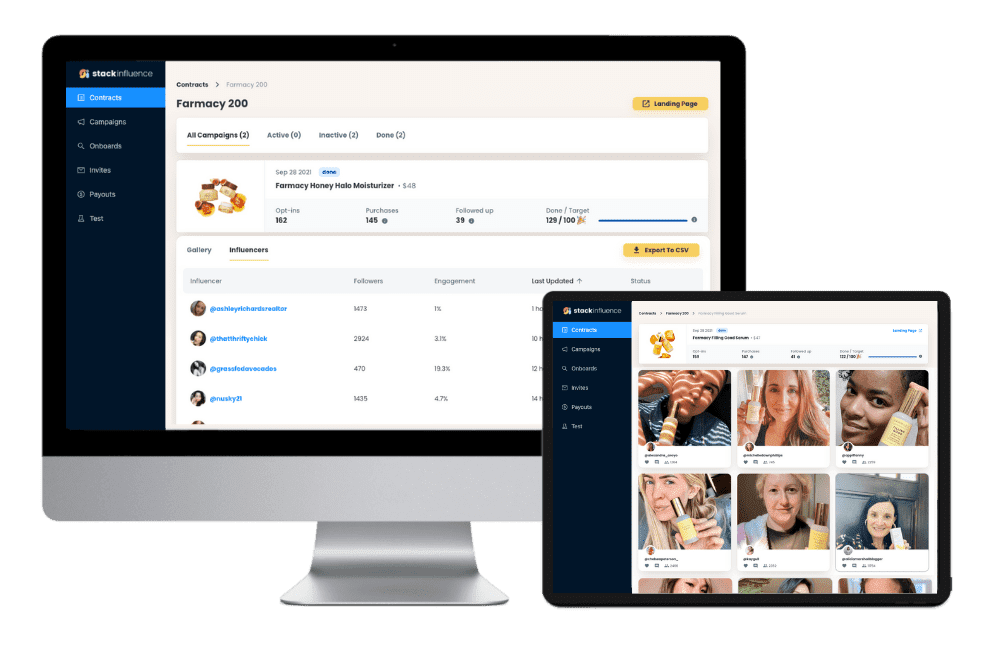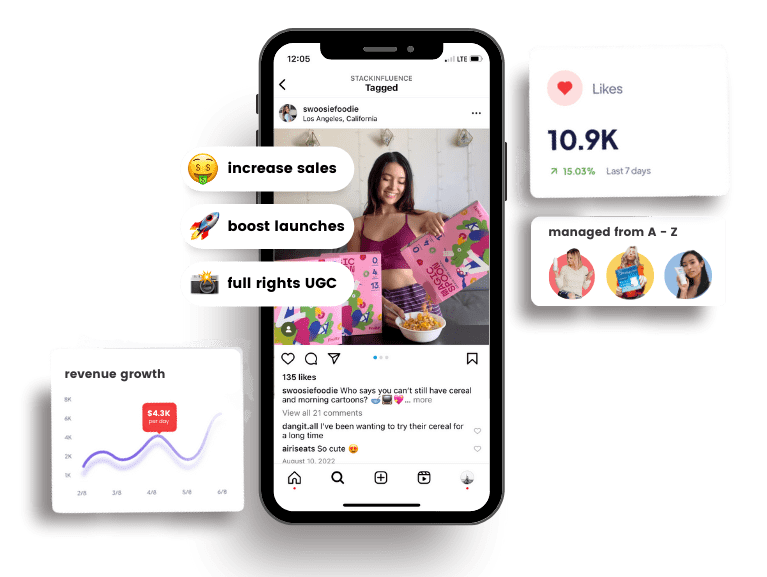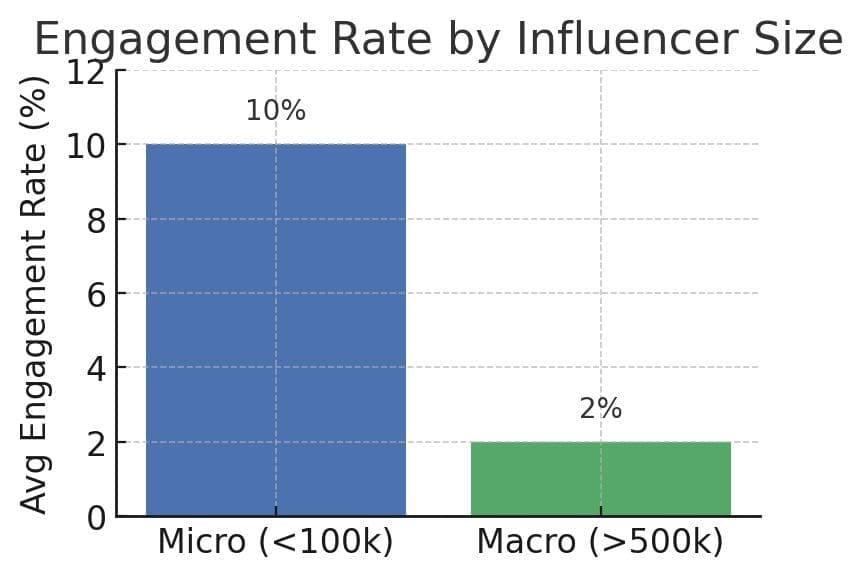Niche Micro-Influencers
20th
August, 2025
Influencer Marketing
Amazon Marketplace
Artificial Intelligence
TikTok Tips
In recent years, marketers have discovered that bigger isn’t always better when it comes to influencer marketing. In fact, 86% of marketers prefer working with influencers who have under 100,000 followers, compared to just 17% who opt for celebrity influencers with over a million. It’s not hard to see why – these “micro” content creators often boast highly engaged, loyal audiences that respond to their recommendations. For e-commerce brands and Amazon sellers, partnering with niche micro-influencers has become a game-changer, providing authentic user-generated content (UGC) and word-of-mouth credibility that traditional ads struggle to match. This blog will explore what niche micro-influencers are, why they’re so effective, and how you can find the right ones to boost your brand.
What Are Niche Micro-Influencers?
A niche micro-influencer is a social media content creator with a relatively small following (often in the 5,000 to 100,000 follower range) who focuses on a specific interest or area of expertise. Unlike macro-influencers or celebrities who appeal to broad audiences, niche micro-influencers zero in on one particular topic or community. This could be anything from gluten-free baking or vintage fashion to bonsai gardening or gadget reviews – whatever their passion and expertise are.
Some common traits of niche micro-influencers include:
- Focus: They stick to a narrow content niche and rarely stray beyond it. Followers know exactly what to expect from a niche creator (e.g. only vegan recipes, or only DIY home hacks), which keeps the audience highly interested and coming back for more.
- Expertise: Because they live and breathe their chosen topic, niche influencers often have deep knowledge or skill in that area. They might be hobbyists-turned-experts or professionals sharing insider tips, giving their content authority and value.
- Authentic Passion: These creators genuinely love their niche subject. Their enthusiasm is contagious and helps form a strong bond with followers. Even with a smaller fanbase, their passion makes the content feel more relatable and trustworthy.
It’s worth noting that “micro” usually refers to follower count, while “niche” refers to content scope. Many niche micro-influencers have a modest follower count by design – not everyone is interested in, say, bonsai tree care or Amazon coupon clipping – but those who do follow are highly interested. Occasionally, a niche creator does explode in popularity (some even reaching millions of followers while still sticking to a niche), but generally these influencers operate in the micro/meso tier. The combination of specific focus + smaller size can be incredibly powerful for brands, as we’ll see next.

Unlock the Power of Micro Influencers and Elevate your Brand Today!

Why Brands Partner with Niche Micro-Influencers
Partnering with niche micro-influencers offers several unique advantages for marketers. These small-scale influencers may not have celebrity reach, but they excel in engagement, authenticity, targeting, and cost-effectiveness. Below we break down the key benefits and why micro-creators are punching above their weight in modern marketing:
Higher Engagement & Loyal Audiences

Average engagement rate on posts by micro- vs macro-influencers.
One big draw of micro-influencers is that their followers are highly engaged. It’s common to see 10% or more of a micro-influencer’s audience actively liking, commenting, and sharing their posts – whereas a macro influencer with a million followers might only get ~2% engagement on a typical post. In other words, a creator with 10k followers could receive 1,000+ interactions (signaling an enthusiastic community), while a celebrity with 1M followers might get 20k interactions (a far more diluted response). This stark contrast is illustrated in the chart above. The stronger loyalty and two-way interaction in micro-influencer communities means brand messages don’t just reach more people proportionately – they resonate more deeply. High engagement not only boosts visibility (thanks to social algorithms favoring active posts) but also indicates a loyal fanbase more likely to act on the influencer’s recommendations.
Authenticity & Trust
Authenticity is the currency of influencer marketing, and niche micro-creators have it in spades. Because they come off as “regular people” passionately sharing what they love, their content feels more like a personal recommendation than an ad. Followers perceive micro-influencers as peers or friends, so endorsements feel organic. In fact, 82% of consumers say they’re highly likely to follow a micro-influencer’s recommendation, according to one survey. This aligns with Nielsen’s finding that 84% of people trust peer recommendations over traditional advertisements. When a micro-influencer raves about a product – whether it’s a new skincare line or a kitchen gadget – their audience knows it’s coming from a genuine place of use and enthusiasm, not a paid script. That trust factor translates into greater credibility for your brand. Nearly 90% of consumers cite authenticity as important in deciding which brands to support, and micro-influencers deliver authenticity in a way glossy celebrity campaigns often cannot. By partnering with these creators, brands inject a sense of realness and relatability into their marketing, which ultimately drives higher conversion rates (as consumers feel more confident following a trusted influencer’s lead).
Precise Niche Targeting
Another advantage is the highly targeted audience that a niche influencer offers. Because each micro-influencer specializes in a particular domain, they have accumulated followers who care deeply about that subject. This allows brands to pinpoint very specific customer segments by choosing influencers whose niche aligns with their product. For example, a company selling eco-friendly yoga mats can collaborate with a micro yoga instructor influencer who focuses on sustainable living – instantly reaching an audience of eco-conscious yoga enthusiasts. Or an indie beauty brand might partner with a cruelty-free makeup micro-influencer rather than a general beauty guru, ensuring their message hits exactly the right demographic. Niche micro-influencers often even have insight into local or regional communities (e.g. a food blogger popular in a particular city), which is gold for geographically targeted campaigns. Overall, working with a group of small, niche-aligned creators can get your brand in front of the precise people who are most likely to be interested, rather than a mass audience where most scroll by. This level of relevance leads to higher quality leads and conversion rates for your marketing efforts.
Cost-Effective with High ROI

Marketing budgets only stretch so far, and here micro-influencers shine brightly. Partnering with micro-influencers tends to be dramatically more cost-effective than hiring big-name influencers or running large ad campaigns. Many micros will create content for the price of a free product sample or a modest fee – perhaps a few hundred dollars or even just some freebies – whereas a single post from a mega-influencer can run into the tens (or hundreds) of thousands of dollars. This means for the cost of one celebrity endorsement, a brand could hire dozens of micro-influencers, flooding various niche communities with content and multiplying the overall reach and impact. The return on investment (ROI) speaks for itself. Research indicates micro-influencer campaigns can deliver around a 20:1 ROI, compared to roughly 6:1 ROI for macro-influencer campaigns. Put simply, a marketing dollar spent on curated micro-influencer partnerships can generate 3x or more the sales of that same dollar spent on a celebrity influencer campaign. The chart below illustrates this contrast in ROI. It’s driven by a combination of factors we’ve discussed – lower upfront cost, higher engagement, more trust, and better targeting – all stacking up in favor of micros.
Relative ROI of micro-influencer campaigns vs. macro-influencer campaigns (revenue generated per $1 spent). Micro collaborations yield significantly greater returns on average.
From a practical budgeting standpoint, micro-influencers are a low-risk, high-reward proposition. You can run small tests with a handful of creators, see real results, and scale up as needed – all while keeping costs manageable. For lean marketing teams or brands with limited ad budgets, micros offer a way to compete with creative, authentic campaigns without breaking the bank. And even larger brands find that the efficiency of micro-influencer content (in terms of ROI) lets them maximize the impact of their marketing spend. It’s no surprise that surveys show the vast majority of brands – big and small – are shifting their influencer strategy toward micro and nano influencers for these very reasons.
How Micro-Influencers Drive E-Commerce Success (UGC & Amazon Strategies)
Working with niche micro-influencers is especially beneficial for online brands, e-commerce retailers, and Amazon sellers. These creators excel at producing user-generated content (UGC) and genuine product endorsements that build trust in an online shopping environment. Let’s look at a few ways micro-influencers can turbocharge e-commerce marketing:
Authentic UGC that Boosts Conversions
Micro-influencers don’t just promote your product – they also create photos, videos, reviews, and tutorials featuring it. This user-generated content can be a treasure trove for your brand’s marketing. Shoppers tend to trust content from real users far more than polished brand ads. In fact, a whopping 90% of consumers say authenticity is important when choosing which brands to support, and UGC is often viewed as the most authentic form of content. By showcasing real-life experiences and honest opinions, micro-influencer content serves as modern word-of-mouth marketing. A follower might see a micro fashion blogger confidently styling your boutique’s sweater in an Instagram Reel, and it feels like a friend’s recommendation rather than an ad – instantly making the viewer more comfortable with the idea of buying. Brands can also repurpose influencer UGC across their own channels. For example, an influencer’s unboxing video or before-and-after photo can be featured on your product pages, social media, or even turned into paid ads. These UGC-based ads often outperform traditional ads because they feel more genuine (studies show UGC ads get higher click-through rates and lower cost-per-click than typical brand-created ads). In short, micro-influencers supply a steady stream of relatable, trust-building content that can significantly boost your conversion rates and credibility online.
Driving Amazon Sales & Reviews
For Amazon sellers, micro-influencers offer a secret weapon to stand out in the crowded marketplace. Amazon’s platform rewards products that generate buzz and outside traffic, and micro-influencers can deliver both. One approach is through the Amazon Influencer Program, where influencers (big or small) create their own Amazon storefront pages to recommend products. When a niche influencer features your item on their Amazon storefront or shares an “Amazon find” on TikTok, it creates a seamless path for their followers to click through and purchase on Amazon. This not only generates immediate sales, but that burst of external traffic and sales can boost your product’s ranking within Amazon’s search results – a win-win for visibility. Even outside of Amazon’s official program, micro-influencer partnerships can lead to more product reviews and social proof on your listings. For example, you might give a micro-influencer a free product or discount code in exchange for them posting an honest review or how-to video on their social channels. Their followers see a trusted person using the product and can swipe up or follow an affiliate link to buy on Amazon. As those new customers purchase, many will leave positive reviews on your product page, strengthening your Amazon reputation. The influencer’s content itself can sometimes be added to your listing (e.g. short video reviews in the “Related video shorts” section on Amazon), making your product page more engaging.
Cost Savings vs. Paid Ads
Micro-influencer marketing can often yield better results than equivalent spend on traditional digital ads, especially on Amazon. Amazon Pay-Per-Click (PPC) ads have become notoriously expensive, driving up sellers’ acquisition costs. Micro-influencers present a more cost-effective alternative. Consider this example: instead of spending $1000 on Amazon Sponsored Product ads (which might get ignored by “ad-blind” consumers), a seller could use that $1000 to send free products to 10 micro-influencers in their niche. Those 10 creators will each produce content – a review, a demo, a testimonial – reaching highly targeted audiences that trust their opinion. The cumulative reach and influence of those posts can far exceed what $1000 of ads might accomplish, and the content stays online generating “free” impressions over time. Plus, that $1000 may also result in multiple pieces of reusable content and several new reviews on Amazon, adding long-term value. This kind of organic buzz is something ads alone can’t buy. It’s telling that 72% of teens (a key up-and-coming consumer demographic) follow influencers and trust their product recommendations, far more than traditional ads. In the e-commerce world, micro-influencers essentially serve as trust bridges – they humanize your brand and lend it credibility among skeptical online shoppers, all at a fraction of the cost of big ad campaigns.

Unlock the Power of Micro Influencers and Elevate your Brand Today!

How to Find the Right Niche Micro-Influencers for Your Brand
By now, the benefits of working with micro-influencers are clear – but discovering the right creators is its own challenge. Unlike mega influencers, niche micro-influencers aren’t always in plain sight or represented by talent agencies, so you’ll need to do a bit of digging. Here are some effective strategies for marketers to find and connect with micro-influencers who perfectly fit your brand:
1. Know Your Niche & Audience
Start by clarifying the specific niche or community you want to target. The more clearly you define the interests, demographics, and values of your ideal customers, the easier it is to spot influencers who speak to that group. For example, if you sell organic pet food, you might look for micro-influencers who are holistic pet care bloggers or dog moms focused on nutrition. Having a solid grasp of your niche will act as a compass in your search – you’ll know the subtopics or hashtags to explore and the type of voice that resonates with your audience.
2. Search Social Platforms & Hashtags
Organic discovery on social media is a great way to find genuine niche creators. Use platform-specific tools or simple searches on Instagram, TikTok, YouTube, or Pinterest to uncover influencers in your domain. Keywords and hashtags are your friends: if you’re a travel accessories brand, you might search Instagram for “#vanlife” or YouTube for “travel vlog gear”. On TikTok, niche communities often rally around tags like #BookTok (for book lovers) or #PlantTok (for plant enthusiasts). Scroll through the content – when you find a person consistently posting high-quality content in that niche with a moderate following (say 5k, 20k, or 50k followers), you’ve likely found a micro-influencer. Pay attention to engagement: 500 likes on an account with 5,000 followers is a great sign of an active following. Also, check who’s commenting – if you see genuine discussions or loyal fans, that creator has influence. Tip: sometimes your own brand’s followers can lead you to micro-influencers. See if any customers or fans tagging your products have a bit of a following themselves.
3. Leverage Communities and Forums
Don’t limit your search to just the big social platforms. Many niche influencers also hang out in Facebook Groups, Reddit communities, or forums related to their topic. For instance, a micro-influencer in the keto dieting niche might be active in a popular Facebook group for keto recipes, sharing their YouTube videos there. Similarly, a tech gadget reviewer might post in a subreddit for tech enthusiasts. Join the communities relevant to your industry and keep an eye out for members who frequently create content or have a following outside the group. You might even post a friendly query like, “Hey, does anyone know good Instagram accounts or YouTubers who cover [your niche]?” – you’d be surprised how people love to recommend their favorite niche creators.
4. Use Influencer Discovery Tools
To save time, consider using dedicated influencer marketing platforms or databases. There are tools (both free and paid) that let you search for influencers by topic, follower size, engagement rate, location, etc. For example, the TikTok Creator Marketplace allows brands to filter creators by category and audience metrics, and platforms like AspireIQ, Upfluence, or CreatorIQ have extensive databases of influencers across social networks. These tools can quickly surface hundreds of potential micro-influencers for you to vet. Additionally, there are clever services like SparkToro that help find influencers your target audience already follows. And of course, some platforms focus specifically on micro-influencers. (For example, Stack Influence is a marketing platform geared toward connecting e-commerce brands with vetted micro-influencers, making it easier to run product seeding campaigns at scale.) Using these tools can streamline the discovery process – but you’ll still want to review each creator’s content for quality and ensure they align with your brand values before reaching out.

Unlock the Power of Micro Influencers and Elevate your Brand Today!

Conclusion to Niche Micro-Influencers
Niche micro-influencers represent the future of relatable, effective marketing. These small-scale creators bring together the best of both worlds – the authenticity and community-feel of a loyal friend, and the reach and creative skills of a digital marketer. By tapping into micro-influencers, brands can access highly targeted audiences, build trust through genuine content, and ultimately drive more e-commerce growth without the hefty price tag of traditional campaigns. Whether you’re an Amazon seller looking to boost product reviews or a DTC brand seeking engaging UGC for social media ads, micro-influencers can deliver results that far outsize their follower counts. The key is to find the right niche personalities who align with your brand and to collaborate in a way that lets their authenticity shine. In an era when consumers value relatability and trust more than ever, partnering with niche micro-influencers might just be the smartest marketing move you make this year. Embrace the power of “small” – and watch how big an impact it can have on your business.

By William Gasner
CMO at Stack Influence
William Gasner is the CMO of Stack Influence, he's a 6X founder, a 7-Figure eCommerce seller, and has been featured in leading publications like Forbes, Business Insider, and Wired for his thoughts on the influencer marketing and eCommerce industries.
Want new articles before they get published? Subscribe to our Awesome Newsletter.
stack up your influence
turning creativity into currency
our headquarters
111 NE 1st St, Miami, FL 33132
our contact info
[email protected]
stack up your influence
turning creativity into currency
our headquarters
111 NE 1st St, 8th Floor
Miami, FL 33132


